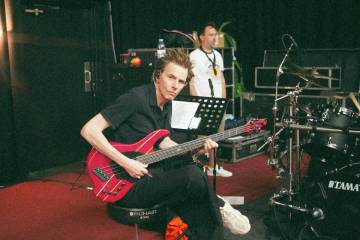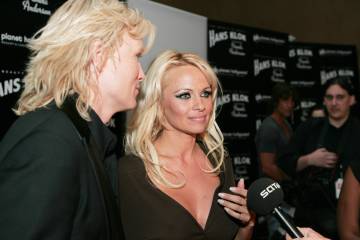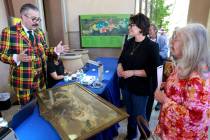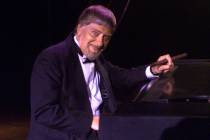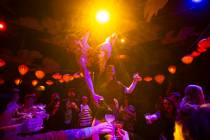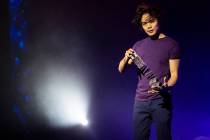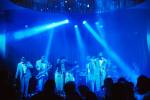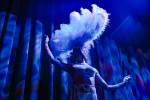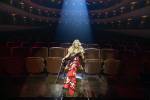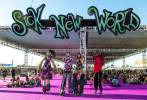The Smith Center – A Year in the Arts: Smith Center wins fans onstage and off
The date: Oct. 29, 2012.
The place: backstage at Reynolds Hall, the 2,050-seat centerpiece of The Smith Center for the Performing Arts.
Maestro Zubin Mehta, who’s just finished conducting the Israel Philharmonic in concert, tells his agent, “There’s no doubt about it — this is one of the great halls.”
Smith Center President Myron Martin’s still trying to get Mehta to put that sentiment in writing.
“But I heard it,” Martin says.
And in the year since The Smith Center opened its door, Martin’s heard that sort of thing — a lot.
From touring artists and resident companies, about everything from onstage acoustics to backstage amenities, The Smith Center’s trio of performance spaces have attracted rave reviews from performers.
Some of whom were, quite frankly, surprised to see such an impressive venue in, of all places, Las Vegas.
“I sure was,” says British pianist Kathryn Stott, who joined superstar cellist Yo-Yo Ma — who’s been her musical collaborator since the mid-1980s — for a Reynolds Hall concert in April. “I was slightly shocked. Maybe that’s not a good thing.”
But it’s an understandable one.
“I had never been to Vegas,” Stott says. And she and her fellow musicians “had been saying for years, ‘Why haven’t we ever given a recital there?’ ”
Now that she has, however, Stott can tell her friends, “it is a great hall — and I’m not just saying that.”
Banjo virtuoso Bela Fleck seconds that emotion.
Fleck played the first regularly scheduled Reynolds Hall concert with his group the Flecktones a year ago — and returns March 29 with legendary jazz pianist Chick Corea.
“I was surprised,” Fleck says in an email . He calls Las Vegas “an unlikely location for such a gem.”
And when Fleck says “gem,” he means it, describing Reynolds Hall as “in the very small tier of halls that look great but sound superb. It kicks serious butt, it’s one of best — seriously.”
As for Cabaret Jazz, singer Jane Monheit — who’s performed there twice and is “in talks” to return — calls it “one of the loveliest venues in the country. And I’ve played ’em all.”
Cabaret Jazz regular Clint Holmes, who performed with Monheit and composer Frank Wildhorn in November, says the club has “become a real focal point” for musicians. Even those who “would never come to Vegas — who wouldn’t think of coming to Vegas” before it existed.
Now that they’ve “heard about The Smith Center — how great the sound is, how great the vibe is” — it’s on their radar, Holmes says.
All of which is music to the ears of Smith Center officials — and to Las Vegas-based artists who share the center with touring performers.
“When you look out from that stage, the grandeur of all that is amazing,” says James Canfield, artistic director of Nevada Ballet Theatre, one of the center’s resident companies. The dancers are “thinking, ‘This is our Lincoln Center, our Kennedy Center. This is the real deal.’ ”
Dancing in Reynolds Hall is “truly a gift to us,” says dancer Alissa Dale, who’s in her ninth season with the company. “I feel like the dancers and the audience both have a new feeling of pride for the ballet company, and the theater being ours now.”
Indeed, when Seattle’s Pacific Northwest Ballet and Salt Lake City’s Ballet joined NBT in October for “Jewels,” the visiting companies “gloated over the facility and how lucky we were,” Canfield says. “They were very supportive — and envious as well.”
Las Vegas Philharmonic musicians, who also call Reynolds Hall home, feel a new spirit, even if it’s only on a subconscious level, says principal oboist Stephen Caplan, a music professor at the University of Nevada, Las Vegas.
“You’ve got to think there’s something subconscious, being in such a beautiful space,” he says. “We’re playing at a higher level now. When the hall’s that beautiful, you want to play up to snuff.”
Dale agrees, acknowledging that “we all know we have to step up our game a little bit.”
But, according to the artists themselves, The Smith Center’s performance spaces — and people — help them give their best.
Much attention has been paid to Reynolds Hall’s acoustics — and for good reason, says pianist David Loeb, UNLV’s director of jazz studies, who’s appeared there twice with the Las Vegas Philharmonic (once as a soloist, once as part of a UNLV jazz quartet). Loeb also played for, and conducted, Ben Vereen’s solo show “Steppin’ Out” in November.
“It’s a world-class concert performance venue,” Loeb says of Reynolds Hall, citing “the acoustics — and the ability to adapt the acoustics to different ensembles. That’s what makes it unique.”
In Fleck’s view, “the sound there was very enjoyable and brought out subtle qualities in our music that don’t always show themselves,” he emails. “A great hall can do that.”
And for dancers, special flooring at Reynolds Hall “absorbs the shock of the physical execution,” Canfield says, as well as “the banging of the pointe shoes,” making for “a quieter aesthetic” in performance.
The one problem with Reynolds Hall as a dance venue? “When you look at dance, you want to see the feet,” Canfield explains. “And some people have mentioned that you can’t see the (dancers’) feet from the first few rows.”
To performers, however, The Smith Center’s back stage can be just as important as the stage itself.
“One of the things that impressed me about The Smith Center is how comfortable it is,” says Matthew Rushing, rehearsal director and guest artist with the Alvin Ailey American Dance Theater, which made its Reynolds Hall debut in March 2012, The Smith Center’s first month of operation.
Warming up backstage, the atmosphere “affects your mood,” Rushing says. Because “all artists deal with is emotion, if the environment backstage is comforting, (and) soothing, in a sense, it’s inspiring.”
Stott praises Reynolds Hall’s “most fabulous backstage,” adding that “I don’t think I ever had a dressing room quite that big.”
In some venues, “it’s cold, there isn’t a nice chair to sit on, or maybe you want to lie down,” she says. “Anything that makes you feel good before you perform — it’s just the little things that make you feel nice and comfortable and calm” before playing.
Or, as Canfield says, “when you’re a dancer, and you have a shower — that’s important.”
The human touch also plays a major role in The Smith Center’s success.
“The facility is one thing, but if there’s no soul ... ” Canfield says, describing the center’s “tremendous crew” as “really, really helpful. They’re the guys behind the scenes.”
Norma Morrow, co-founder of the Jewish Repertory Theatre of Nevada, echoes Canfield’s praise.
“Whatever we need, they’re so accommodating,” says Morrow, who appeared in the theater group’s female version of “The Odd Couple” in the center’s Troesh Studio Theater in November. “If a curtain needs to be here, or a light needs to be there, they do it.”
And Cabaret Jazz, in Monheit’s view, “is one of the only places where every last single detail is nailed,” she says. “From Myron (Martin) on down, everyone is genuinely excited about music and excited about what it can bring.”
Holmes agrees, noting that in Cabaret Jazz — for both performers and audience — it’s “about the music. It’s not necessarily about the flash and dazzle.” After all, “they took out the spotlight, and that’s very anti-Vegas.”
Similarly, at the Troesh, “you really feel the audience,” Morrow says. “It’s exciting as a performer — they’re right there with you. You feel your audience. They’re laughing with you, they’re crying with you.”
Yet even in The Smith Center’s big room, Reynolds Hall, there’s a palpable connection between artist and audience.
“Even with a big stage,” Stott recalls, “we felt the audience weren’t far away.”
Adds Dale, “the energy in that place is mind-blowing,” citing the auditorium’s horseshoe design as a key factor in the feeling of intimacy, “because the balconies are close.”
In Rushing’s view, “the proximity between audience and dancers is so important,” he says. “If we’re too far away, I can’t feel when the audience is enjoying it or not.”
That hasn’t been a problem in The Smith Center’s first year.
“We loved the crowd there,” Fleck emails. “They were very responsive while being great listeners.”
At Las Vegas Philharmonic performances, “the audience seems to be so thrilled,” Caplan says. “And the great audience enthusiasm is telling us great things about the way we sound.”
For Loeb, “the ability to embrace and bring in all these various groups, from Bela Fleck to the symphony,” underscores Reynolds Hall’s world-class status.
“It actually is a world-class hall. Everyone should be very proud of it,” say Stott, whose touring schedule last year took her to the U.S., Europe, Australia and the Far East. “I do see an awful lot of concert halls — and when somebody builds a nice new one, you never take it for granted.”
The same goes for Cabaret Jazz, according to its on stage fans.
“I already feel so at home,” Monheit says. “I will be so disappointed if I don’t get to come back forever.”
Contact reporter Carol Cling at ccling@reviewjournal.com or 702-383-0272.
One Year By The Numbers
4,380 — Number of times the Carillon Tower bells have rung since opening night (daily from 9 a.m. to 8 p.m.)
11,450 — Subscribers to the 2012- 2013 Broadway Las Vegas season
457 — Performances at The Smith Center since opening
420,000 — Tickets sold to patrons over the past year
145 — Private and special events held including weddings, meetings, receptions, dinners, fundraisers and more
47,475 — Guests who have attended special events at The Smith Center
12 — Couples who said "I do" at The Smith Center over the past year
84 — Classrooms across the valley that have hosted a Southern Nevada Wolf Trap artist residency
277 — Early childhood educators who have attended professional development workshops presented by visiting national Wolf Trap Teaching Artists
657 — School buses that transported students to The Smith Center campus
720 — Southern Nevada teachers who participated in professional development workshops presented by Kennedy Center Teaching Artists
1,092 — Preschool children in Las Vegas who have benefited from Southern Nevada Wolf Trap artist residencies
3,667 — Students and teachers who have participated in a classroom demonstration session presented by local, regional and national artists
42,287 — Students and teachers who have attended a performance at The Smith Center
Note: All numbers are from March 2012 and estimated through March 2013
SOURCE: The Smith Center for the Performing Arts







